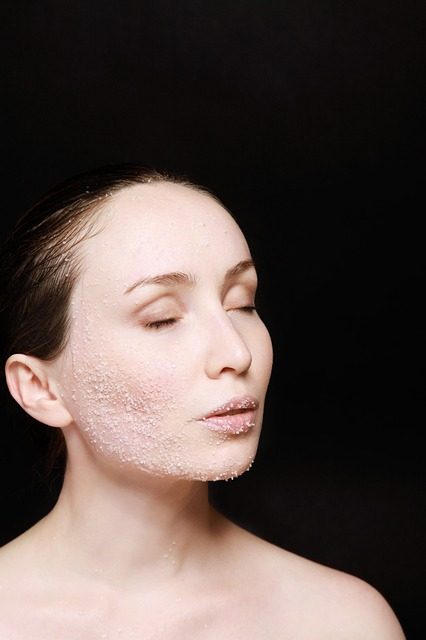Are you tired of harsh exfoliants leaving your sensitive skin feeling irritated and inflamed? Enter mandelic acid: the gentle yet powerful exfoliant that can unlock radiant skin without causing discomfort. Derived from bitter almonds, mandelic acid is a game-changer for those with sensitive or acne-prone skin. But what exactly sets it apart from other alpha hydroxy acids (AHAs), and how can you incorporate it into your skincare routine?
In this blog post, we’ll unveil the magic of mandelic acid, diving into its unique properties and benefits. We’ll compare it to other AHAs, such as glycolic acid, and discuss how mandelic acid peels can revolutionize your skincare game. Plus, we’ll share real-life success stories and expert advice from dermatologists to help you achieve the glowing, healthy skin you deserve.
Table of Contents
Key Takeaways
Discover Mandelic Acid: a gentle AHA with larger molecules suitable for sensitive skin.
Reap the benefits of mandelic acid peels to reduce wrinkles, acne scars and dark spots while improving texture and radiance.
Incorporate into skincare routine safely by patch testing, selecting right product & using sun protection measures when needed.
Discovering Mandelic Acid: A Gentle Alpha Hydroxy Acid

Mandelic acid, an AHA derived from bitter almonds, has gained popularity for its gentle exfoliating properties, making it an ideal choice for those with sensitive or acne-prone skin. Unlike other alpha hydroxy acids like glycolic and lactic acid, mandelic acid has a larger molecular size, which means it penetrates the skin more slowly and causes less irritation. The Ordinary Mandelic Acid 10 is a popular product that harnesses the power of this gentle exfoliant.
This distinguishing feature of mandelic acid differentiates it from other AHAs, like glycolic acid, renowned for its potent exfoliating properties. While glycolic acid peels can deliver dramatic results, they can also be harsh and irritating to sensitive skin types. In contrast, mandelic acid provides a gentler alternative that still effectively addresses various skin concerns, such as acne scars, dark spots, and uneven skin texture.
Comparing Mandelic Acid to Glycolic Acid
With a larger molecular size (152.15 g/mol) than glycolic acid (76.05 g/mol), mandelic acid is recognized for its milder effect on the skin. The larger molecules penetrate the skin more slowly, leading to a reduced risk of irritation and making mandelic acid a more suitable choice for sensitive skin compared to glycolic acid peels.
A comparative study found that a 45% mandelic acid peel was equally effective as a 30% salicylic acid peel in treating mild-to-moderate facial acne, demonstrating its efficacy in skincare without causing excessive irritation.
Additionally, mandelic acid can be combined with other AHAs or beta hydroxy acids (BHAs) for optimal exfoliation and hydration, provided that care is taken to prevent potential skin irritation.
Benefits for Sensitive and Acne-Prone Skin
Given its gentle nature, mandelic acid is an excellent selection for individuals with sensitive or acne-prone skin. It offers several benefits:
Its antibacterial properties help eliminate acne-causing bacteria.
Its ability to reduce inflammation and redness can soothe reactive skin.
Its exfoliating capabilities can improve skin texture.
It can reduce the appearance of hyperpigmentation.
It can diminish fine lines.
Research has shown that products containing 5% or 10% mandelic acid are both safe and effective for treating acne. As the skin develops tolerance, the frequency of mandelic acid usage can be increased, allowing for personalized skincare that caters to individual needs and concerns.
Overall, mandelic acid offers a gentle yet powerful solution for addressing various skin issues without causing unnecessary irritation.
The Power of Mandelic Acid Peels

Mandelic acid peels are chemical peels that utilize the gentle exfoliating properties of mandelic acid to promote skin health and rejuvenation. These peels can help:
Diminish the visibility of wrinkles
Reduce the appearance of fine lines
Fade dark spots
Improve skin texture
Reduce the appearance of acne scars
Curious about the workings of mandelic acid peels? Understand the scientific explanation for their exfoliation and cell regeneration properties, along with their efficiency in handling hyperpigmentation and dark spots.
Exfoliation and Cell Turnover
Mandelic acid peels work by delicately eliminating dead skin cells and stimulating the production of fresh, healthier skin cells. This process of exfoliation and cell turnover refines skin texture, encourages a brighter complexion, and diminishes the visibility of acne.
Increased cell turnover offers numerous advantages for the skin, such as promoting a radiant, youthful appearance, reducing the risk of acne and large pores, and minimizing the appearance of excess pigment. By harnessing the power of mandelic acid peels, you can achieve smoother, healthier skin with a natural glow.
Addressing Hyperpigmentation and Dark Spots
Mandelic acid peels are also effective in reducing hyperpigmentation and dark spots, resulting in a more even complexion. By exfoliating the outer layer of the skin, mandelic acid peels can diminish the appearance of dark spots without affecting the skin’s melanocytes, making it a safe option for darker skin tones.
The effects of mandelic acid peels on hyperpigmentation and dark spots may vary depending on the individual and the severity of the condition. However, with regular use, it is possible to observe improvements in inflammation caused by hyperpigmentation and lightening of dark spots over time. Patience is key, as results may take several weeks or even months to become evident.
Incorporating Mandelic Acid into Your Skincare Routine
If you’re eager to experience the benefits of mandelic acid for yourself, it’s essential to know how to incorporate it into your skincare routine properly. From selecting the right product to determining the appropriate usage frequency, there are several factors to consider to ensure the best results for your skin type and concerns.
This section will navigate you through the steps of integrating mandelic acid into your skincare regime, aiding in achieving the radiant skin you desire.
Learn more, visit Mandelic Acid – How to add it to your skin care routine for glowing skin
Choosing the Right Product
While selecting a suitable mandelic acid product for your skin type and concerns, assess the multitude of options in the market. Mandelic acid is a common ingredient in many skincare products, such as:
Toners
Serums
Deodorants Popular mandelic acid products include cleansers, serums, peel pads, and more, catering to a range of skin concerns and preferences.
When selecting a mandelic acid product, it’s crucial to consider your skin type, be it oily, normal, dry, or combination. Mandelic acid is suitable for all skin types and can help with:
Balancing excess oil
Refining pores
Evening out skin tone and texture
Providing gentle exfoliation
Identifying the product that best suits your skin concerns and preferences is key to achieving optimal results.
Patch Testing and Usage Frequency
Prior to fully immersing in your new skincare routine with mandelic acid, performing a patch test is of utmost importance to verify the product’s compatibility with your skin. Here’s how to do a patch test:
Apply a small amount of the product to a small, less noticeable patch of skin, such as the inner arm.
Leave it on for 24-48 hours without washing, rubbing, or touching the area.
If no negative reactions occur, you can safely incorporate the mandelic acid product into your skincare routine.
The frequency of mandelic acid usage may vary depending on your skin’s response to acids. It is advisable to begin with once or twice a week and gradually increase the frequency as needed. By adjusting your usage according to your skin’s needs, you can enjoy the benefits of mandelic acid without causing unnecessary irritation or sensitivity.
Success Stories: Real-Life Experiences with Mandelic Acid
Mandelic acid has transformed the complexions of countless individuals, addressing a variety of skin issues such as acne, folliculitis, and hyperpigmentation. By incorporating mandelic acid into their skincare routines, many users have achieved an even-toned, radiant complexion and improved skin texture.
You can find reviews of mandelic acid’s effectiveness on various platforms, including:
Amazon
Beautiful with Brains
Sephora
Popsugar
Beauty Spark Review
These reviews often showcase before and after photos, highlighting the visible improvements in skin within two to three weeks of consistent use. With the right product and usage frequency, mandelic acid could be the key to unlocking your skin’s true potential.
Expert Advice: Dermatologists Weigh In on Mandelic Acid
Just like any other skincare ingredient, securing expert advice is paramount to guarantee the safe and effective usage of mandelic acid. Dermatologists recommend incorporating mandelic acid into your nighttime skincare routine following cleansing and prior to moisturizing. Additionally, they suggest using lower concentrations of mandelic acid and other acids, such as vitamin C, to reduce the chance of adverse effects.
This section will delve into dermatologist’s advice on sun protection measures while using mandelic acid, along with possible interactions with other acids and active components in your skincare routine.
Sun Exposure and Protective Measures
Sun protection is vital when using mandelic acid, as AHAs can increase the skin’s sensitivity to UV light. To minimize the risk of sun damage, dermatologists recommend using a broad-spectrum sunscreen with a minimum SPF of 30.
Popular sunscreens to pair with your mandelic acid routine include:
Nektalova
Caudalie Anti-Wrinkle Face Suncare SPF50
Supergoop! Play Everyday Lotion SPF 50
EltaMD UV Clear Broad-Spectrum SPF 46
By ensuring adequate sun protection, you can enjoy the benefits of mandelic acid without worrying about the potential for sun damage.
Interactions with Other Acids and Active Ingredients
Mandelic acid can be combined with other AHAs, such as glycolic acid and lactic acid, for increased efficacy. It may also be layered with BHAs, like salicylic acid, to promote optimal exfoliation and hydration. However, care should be taken when combining mandelic acid with other acids to prevent potential skin irritation.
When it comes to combining mandelic acid with other active ingredients, such as vitamin C, experts suggest:
Using lower concentrations to reduce the chance of irritation and sensitivity
Carefully considering the interactions between mandelic acid and other skincare ingredients
Creating a tailored skincare routine that delivers the best results for your skin
Summary
Mandelic acid is a powerful yet gentle exfoliant that offers a multitude of benefits for sensitive and acne-prone skin. Its larger molecular size sets it apart from other AHAs, making it an ideal choice for those seeking a gentler alternative to glycolic acid peels. With its ability to promote exfoliation, cell turnover, and address hyperpigmentation and dark spots, mandelic acid can be a game-changer for your skincare routine.
By incorporating mandelic acid into your regimen with the right product and usage frequency, you can unlock radiant, healthy skin. Remember to heed expert advice, practice sun protection, and consider potential interactions with other skincare ingredients to ensure the best results. With patience and consistency, mandelic acid could be the key to revealing your skin’s true potential.
Frequently Asked Questions
What does mandelic acid do to your skin?
Mandelic acid is a gentle AHA that helps to reduce acne, fine lines, wrinkles, and improve the appearance of uneven skin. As we age, skin renewal slows down, causing our skin to lose elasticity, discolor, and develop signs of aging, so mandelic acid can help combat these changes.
Is it safe to use mandelic acid everyday?
Mandelic acid is suitable for all skin types and can be used daily, though it’s recommended to begin with lower percentages and increase gradually as your skin adapts.
Is mandelic acid better than retinol?
It depends on your desired skin results. Retinol is renowned for anti-ageing, while mandelic acid is better for acne and hyperpigmentation.
What not to mix with mandelic acid?
It is best to avoid mixing mandelic acid with other acids like lactic acid, glycolic acid, salicylic acid, etc. as this can cause over-exfoliation and discomfort.
What sets mandelic acid apart from other alpha hydroxy acids?
Mandelic acid, with its larger molecular size, is more gentle on the skin than other alpha hydroxy acids, making it an ideal choice for those with sensitive and acne-prone skin.









